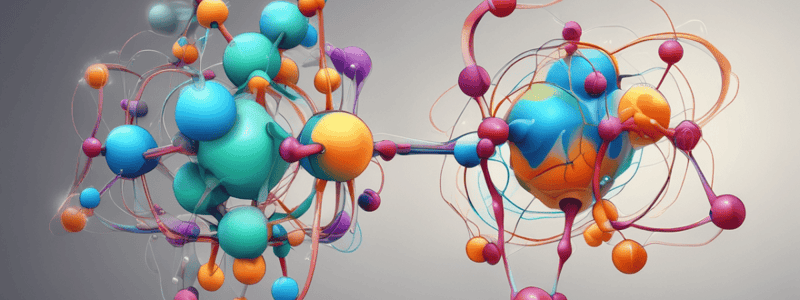Podcast
Questions and Answers
What is the primary reason why covalent compounds do not conduct electricity when molten or in solution?
What is the primary reason why covalent compounds do not conduct electricity when molten or in solution?
They do not break up to form ions.
What is the characteristic of ionic compounds that is responsible for their high melting and boiling points?
What is the characteristic of ionic compounds that is responsible for their high melting and boiling points?
The electrostatic force of attraction between oppositely charged ions.
What is the difference between a σ (sigma) bond and a π (pi) bond?
What is the difference between a σ (sigma) bond and a π (pi) bond?
A σ bond is formed by the end-on overlap of orbitals, while a π bond is formed by the sideways overlap of p-orbitals.
What is the term used to describe the electrons shared in a covalent bond?
What is the term used to describe the electrons shared in a covalent bond?
What is the characteristic of covalent compounds that distinguishes them from ionic compounds?
What is the characteristic of covalent compounds that distinguishes them from ionic compounds?
What is the characteristic of a polar covalent bond?
What is the characteristic of a polar covalent bond?
What is the tendency of atoms to achieve an octet in their outermost energy level, and how does it relate to chemical bonding?
What is the tendency of atoms to achieve an octet in their outermost energy level, and how does it relate to chemical bonding?
What is the difference between an atom and an ion, and how does it relate to ionic bonding?
What is the difference between an atom and an ion, and how does it relate to ionic bonding?
What is the significance of valency in chemical bonding, and how does it relate to the formation of compounds?
What is the significance of valency in chemical bonding, and how does it relate to the formation of compounds?
What is the significance of lone pairs in covalent bonding, and how do they differ from bond pairs?
What is the significance of lone pairs in covalent bonding, and how do they differ from bond pairs?
Define electronegativity?
Define electronegativity?
What is the significance of electronegativity in the formation of polar covalent bonds, and how do they differ from nonpolar covalent bonds?
What is the significance of electronegativity in the formation of polar covalent bonds, and how do they differ from nonpolar covalent bonds?
Flashcards are hidden until you start studying




